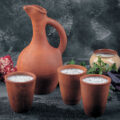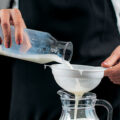- Айран — уникальный напиток народов Кавказа / Ayran is a unique beverage of the Caucasus
- Процесс приготовления кефира / The kefir making process
- Ряженка с ягодами / Ryazhenka with berries
Kefir, sour cream and cottage cheese are staples of a Russian family’s diet. It is not for nothing that the Committee for the Development of Tourism of St. Petersburg, a city that is a UNESCO Creative City of Gastronomy, included cheese pancakes, along with regular pancakes and kasha, in the St. Petersburg Breakfast Concept, entrusting cottage cheese with the mission to represent Russia’s gastronomic DNA.
Love story
Fermented milk products are among the oldest in any cuisine. You don’t even need to cook them: left in a warm place, milk will turn into curdled milk. The culprit is lactic acid bacteria, which convert milk sugar (lactose) into lactic acid. Fermented milk is healthy, tasty, and lasts longer than fresh milk. Moreover, fermented milk products open up plenty of opportunities for experiments. Thus, Russians came up with the idea of fermenting baked rather than fresh milk to produce ryazhenka — baked yogurt with a subtle, sweetish taste.
The peoples of the Volga region boiled milk, evaporating it by a third before fermentation, and drank thick acidic qatiq. In the Caucasus, ayran was held in high esteem — a milk beverage made by fermenting cow, goat or sheep milk; it was diluted with mineral or plain water and lightly salted to enhance its thirst-quenching properties. Ayran’s closest relative, kefir, became a Soviet culinary brand. Kefir undergoes both lactic acid and ethanol fermentation; it owes its unique taste to the kefir fungus.
According to legend, the prophet Mohammed brought the yellowish grains of this fungus to the inhabitants of the North Caucasus in his staff, strictly forbidding them to share the fungus with the unfaithful. In the 19th century, Russian doctors became interested in the health benefits of kefir. They approached dairy manufacturers, the Blandov brothers, with an idea to establish kefir production in Russia.
The Blandov brothers did a clever thing: they sent a young employee named Irina Sakharova to the Caucasus. In Kislovodsk, the guest from Moscow met with Karachai prince Bek-Murza Baichorov, who supplied the Blandovs with milk. The prince was smitten. Irina later recalled, “Every morning I would receive a bouquet of roses with a note saying ‘Young lady, do come to the Alley of Love’.” Although Sakharova did not respond to Bek-Murza’s advances, she did get the coveted “grains of Mohammed” from him. The first batch of kefir was produced in Moscow in 1908 and delivered to the Botkin Hospital as a medicinal product. In the USSR, kefir was omnipresent: students and workers snacked on “a bottle of kefir and half a loaf”, Soviet women did kefir fasting, while in kindergartens and sanatoriums an afternoon glass of kefir was a must due to its health benefits. Kefir was even used to make okroshka — a traditional Russian cold soup, which, since time immemorial, has invariably been made with kvass. This is hardly surprising because fermented milk beverages are universal. They make an excellent marinade for poultry and other meat; the kefir or ayran dough is incredibly airy and fluffy. This dough is used to make traditional Kabardian lakums as well as the highlights of Russian cuisine — pancakes and crumpets.
All shades of white
Many nations ferment cream to make a thick sour sauce, but only in Russia this product — sour cream — became a staple of the most popular dishes. A bowl of rich borscht was “whitened” with a spoonful of sour cream to balance the taste of cabbage, beetroot and meat broth. Stuffed cabbage rolls, pancakes and vareniki were often served with sour cream. Russian cuisine abounds in mushroom, fish and meat dishes stewed in sour cream. Thanks to its fat content and moderate acidity, sour cream makes meat softer and eliminates the distinct fishy smell. In Buryatia and Yakutia, locals use sour cream to make salamat by heating sour cream and butter in a cast-iron frying pan and gradually adding sifted flour and water. The dish is ready when oil gathers along the edges and the surface is covered with a golden crust. Salamat is served in bowls and consumed hot.
Cottage cheese is made by separating the whey from a fermented milk beverage. There were many cottage cheese varieties in Russia. The Bashkirs and Tatars made eremchek, or red cottage cheese. As a result of long cooking and slow simmering it acquired a reddish tint. The main thing about eremchek, though, is not color, but its caramel-creamy taste, which makes it a perfect filling for the traditional gubadiya pie. In the Don region, suzma cottage cheese was popular. Fresh suzma was soft and tender and could be spread on bread like butter. It was also used instead of sour cream or diluted with whey to make a refreshing drink. The poet Nikolai Turoverov mentions this versatile product in a poem about the Cossack diet: “Yesterday the Cossacks received white bread, suzma and balyk from the Don …”.
Remarkably, in different regions of Russia people appreciated the gastronomic potential of cottage cheese as a filling: Chechens cooked closed chepalgash flatbreads with cottage cheese; in central Russia, delicious round cottage cheese buns, or vatrushki, were baked; in Karelia, cottage cheese replaced pearl barley as a filler for open-faced kalitka pies. During the harsh winters, the inhabitants of the Urals came up with an ingenuous recipe — they mixed cottage cheese with butter, honey and raisins, rolled the mass into balls, exposed them to the cold, and then nibbled on syrchiki like on an ice-cream cone. This delicacy was made once a year, on Christmastide. There is another, much more popular, festive dish made from cottage cheese –the Easter curd pudding, or paskha. Making paskha was a widespread custom in central and northern Russia, where during Easter the weather is still cold enough for cottage cheese to withstand the consecration. The main requirement for cottage cheese is homogeneity, so it was carefully squeezed to separate it from the whey, ground, and mixed with butter, cream, sour cream, raisins, almonds, candied fruits and spices. The mass was placed in a wooden collapsible mold with walls featuring carved images of vines, birds, and ears of cereals. The cottage cheese was then exposed to the cold under a weight for 12 hours. When ready, paskha had the shape of a truncated pyramid and symbolized the Holy Sepulcher — the main Christian shrine.
The Emperor’s breakfast
Cheesecakes, or syrniki, is by far Russia’s most popular dish made from fermented milk products. No one knowns when syrniki were cooked for the first time, but in the 19th century they were considered an old recipe. Ivan Turgenev writes in his novel “Nov”, “We had lunch at 12 o’clock sharp and ate the old dishes: syrniki, pigus, solyanka…”. Originally, however, cheesecakes were actually pancakes folded in four with a curd filling. In the 20th century, syrniki became what they are today — cottage cheese crumpets fried in butter. Despite the simple composition — cottage cheese, flour, eggs — cheesecakes are not at all easy to make. First, you need to carefully balance the dryness of the flour with the moisture of the cottage cheese. Secondly, cheesecakes should have an appetizing golden crust. That’s why they were often fried in ghee rather than in ordinary butter — ghee has a higher melting point. Cheesecakes were served with sour cream or jam. It is a known fact that Nicholas II, the last Russian Emperor, loved to have cheesecakes with raspberry jam for breakfast.
Cheesecakes are so common in Russia today that you can even buy them in a shop as a semi-finished product. Stewler, or varenets, on the other hand, is just beginning to regain well-deserved popularity. This old Russian dish was made from milk, with sour cream as a starter. The main thing in varenets is the foam. The wife of the writer Leo Tolstoy, Sofya Andreevna, emphasized it in her cookbook, “Take unskimmed milk, ideally evening milk, stir and put it in the oven; when it becomes foamy, immerse the foam in the milk and stir; repeat the process several times — the more foam, the tastier the varenets. When the milk becomes reddish, remove it from the oven, let it cool, take it to the cellar and put it on ice.” Varenets is delicious au naturel, but in Russian restaurants its creamy taste is often complemented by fresh berries and fruit.
Fermented milk products are a legacy of the past, but perhaps they will surprise us in the future. For example, Russian scientists expect that by learning to make kefir in space, humanity will be equipped for flights to Mars. The first such experiment took place on board the Soyuz MS-04 spacecraft in 2017. The story of kefir, sour cream and cottage cheese is to be continued.
Tatiana Borisova



